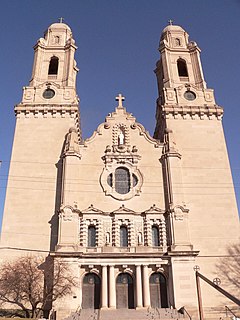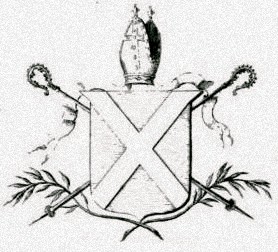List of Dioceses

The Roman Catholic Church in Scotland comprises two ecclesiastical provinces each headed by a metropolitan archbishop. The provinces in turn are subdivided into 6 dioceses and 2 archdioceses, each headed by a bishop or an archbishop, respectively.


In church governance, a diocese or bishopric is the ecclesiastical district under the jurisdiction of a bishop.
An ecclesiastical province is one of the basic forms of jurisdiction in Christian Churches with traditional hierarchical structure, including Western Christianity and Eastern Christianity. In general, an ecclesiastical province consists of several dioceses, one of them being the archdiocese, headed by a metropolitan bishop or archbishop who has ecclesiastical jurisdiction over all other bishops of the province.
The Bishop of Galloway, also called the Bishop of Whithorn, was the eccesiastical head of the Diocese of Galloway, said to have been founded by Saint Ninian in the mid-5th century. The subsequent Anglo-Saxon bishopric was founded in the late 7th century or early 8th century, and the first known bishop was one Pehthelm, "shield of the Picts". According to Anglo-Saxon ecclesiastical tradition, the bishopric was founded by Saint Ninian, a later corruption of the British name Uinniau or Irish Finian; although there is no contemporary evidence, it is quite likely that there had been a British or Hiberno-British bishopric before the Anglo-Saxon takeover. After Heathored, no bishop is known until the apparent resurrection of the diocese in the reign of King Fergus of Galloway. The bishops remained, uniquely for Scottish bishops, the suffragans of the Archbishop of York until 1359 when the pope released the bishopric from requiring metropolitan assent. James I formalised the admission of the diocese into the Scottish church on 26 August 1430 and just as all Scottish sees, Whithorn was to be accountable directly to the pope. The diocese was placed under the metropolitan jurisdiction of St Andrews on 17 August 1472 and then moved to the province of Glasgow on 9 January 1492. The diocese disappeared during the Scottish Reformation, but was recreated by the Catholic Church in 1878 with its cathedra at Dumfries, although it is now based at Ayr.

The Archbishop of Glasgow is an archiepiscopal title that takes its name after the city of Glasgow in Scotland. The position and title were abolished by the Church of Scotland in 1689; and, in the Scottish Episcopal Church, it is now part of the Episcopal bishopric of Glasgow and Galloway. In the Roman Catholic Church, the title was restored by Pope Leo XIII in 1878.

The Roman Catholic Archdiocese of Omaha is a particular church of the Latin Rite of the Catholic Church in the midwestern region of the United States. The archdiocese is currently shepherded by Archbishop George Joseph Lucas, formerly the head of the Springfield, Illinois diocese; he was installed in Omaha on July 22, 2009. The archdiocese serves more than 230,000 Catholics in 23 northeast Nebraska counties in approximately 140 parishes and missions.

The Bishops' Conference of Scotland (BCOS), under the trust of the Catholic National Endowment Trust, and based in Airdrie, North Lanarkshire, is an episcopal conference for archbishops and bishops of the Roman Catholic Church in Scotland. The conference is primarily made up of the presiding bishops of Scotland's eight dioceses as well as bishops who have retired.

The Diocese of Paisley is an ecclesiastical territory or diocese of the Latin Rite of the Catholic Church in Scotland. Erected on 25 May 1947 from the Archdiocese of Glasgow, the diocese covers the historic county of Renfrewshire and is 580 km2 (220 sq mi) in area making it the smallest diocese by area in Scotland.

The Catholic Church in Scotland overseen by the Scottish Bishops' Conference, is part of the worldwide Catholic Church headed by the Pope. After being firmly established in Scotland for nearly a millennium, the Catholic Church was outlawed following the Scottish Reformation in 1560. Catholic Emancipation in 1793 and 1829 helped Catholics regain both religious and civil rights. In 1878, the Catholic hierarchy was formally restored. Throughout these changes, several pockets in Scotland retained a significant pre-Reformation Catholic population, including Banffshire, the Hebrides, and more northern parts of the Highlands, Galloway at Terregles House, Munches House, Kirkconnell House, New Abbey and Parton House and at Traquair in Peebleshire.

A pro-cathedral is a parish church that is temporarily serving as the cathedral or co-cathedral of a diocese or has the same function in a Catholic missionary jurisdiction that is not yet entitled to a proper cathedral, such as an apostolic prefecture or apostolic administration. It is distinct from a proto-cathedral, the term in the Roman Catholic Church for a former cathedral, which typically results from moving an episcopal see to another cathedral, in the same or another city. In a broader context, the term 'proto-cathedral' may be used of a church used by a bishop before a settled cathedral has been designated.
The re-establishment of the hierarchy of the Catholic Church in Scotland took effect on 15 March 1878. This followed the restoration of the English hierarchy in 1850.

The Archdiocese of Glasgow is the metropolitan see of the Province of Glasgow in the Roman Catholic Church in Scotland. The episcopal seat of the developing diocese was established by Saint Kentigern in the 6th century AD. It is one of two Latin Church metropolitan archdioceses of the Roman Catholic Church: the only archdioceses in Scotland. It is the elder of the two bishoprics. Innocent VIII first raised Glasgow a metropolitan archbishopric in 1492. The Metropolis has the dioceses of Motherwell and Paisley as suffragans within the Ecclesiastical Province.

The Catholic Church in Ecuador comprises only a Latin hierarchy, united in a national episcopal conference, which comprises:

The Diocese or Archdiocese of St Andrews was a territorial episcopal jurisdiction in early modern and medieval Scotland. It was the largest, most populous and wealthiest diocese of the medieval Scottish church, with territory in eastern Scotland stretching from Berwickshire and the Anglo-Scottish border to Aberdeenshire.

James Donald Scanlan was a Roman Catholic prelate who served first as the Bishop of Dunkeld, then Bishop of Motherwell, and ultimately Archbishop of Glasgow. Born in Glasgow, Scanlan intended to study medicine, but was sent to Sandhurst and served with the Highland Light Infantry. After military service, he earned a law degree from the University of Glasgow before decided to enter the priesthood. He was ordained in 1929.